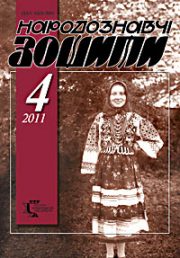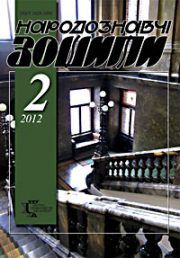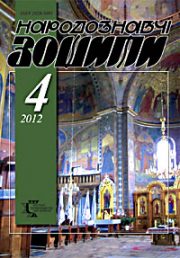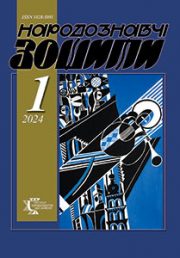The Ethnology Notebooks. 2019, № 4 (148), 833—841
УДК 801.81:398.8:[7.045:2-135.3]
DOI https://doi.org/10.15407/nz2019.04.833
FOLKLORE AND ETHNOGRAPHIC DUALITY: THE MECHANISM AND INTERACTION OF TEXTUAL MODELS
KOVAL Halyna
ORCID ID: https://orcid.org/0000-0002-2998-2357
candidate of Philological Sciences (PhD),
Senior Researcher at FolkloreDepartment
Institute of Ethnography of National Academy of Sciences of Ukraine
Svobody Avenue 15, 79000, Lviv, Ukraine.
Contacts: e-mail: galyna.kov@gmail.com
Abstract. In the article, we use the term reduplication to consider the folklore text model, since it’s based on a repetition of the rite and its elements in the song. We are talking about such a phenomenon as a repetition of rites, which are ordinary elements in a folk song, or just its nomination. It’s a peculiar identity of actions of the participants in the spectacle, which indicates the ancient syncretism of the phenomenon. In the study, it is important to understand the poetics of words and actions that figuratively complement each other. It is necessary to determine the system of linguistic, communicative, folk and ethnographic factors that form the reduplications of the structure. The word that became detached from the rite takes on additional functions. At this stage, it is not enough to independently express magical meaning without ritual actions. Belief in the magic of action and the word rite originated from its rethought and then disappears, the verbal text remains, it does not fully interact with the rite. This applies to those genres where verbal texts have been preserved, and the ceremonial accompaniment has disappeared.
The reduplication phenomenon appears at the level of nominating the rite, the participants and their actions. A number of texts contain information about traditional ceremonial dishes (kutya, uzvar, porridge) and others. The spatial locus is often repeated, where a certain ritual action takes place: the decoration of a Bush and escorting mermaids takes place in the forest. Separate actions are being reduplicated — «Kupala cleaning» and attributes — «flowers, wreaths, a candle». The emphasis on these elements in the rite and songs reinforces the significance and symbolism of the images.
Often duality (in the song — in the rite) manifests itself in ceremonial attributes — the ceremonial wreath, the last sheaf of «beard», the «field grandfather», in accordance with which the folk tradition consolidated the symbolic meaning of power and immortality.
Folklore and ethnographic reduplication can be seen in the New Year cycle. Ritual visual plowing was intensified by the verbal and poetic form of expression.
Reduplication is reflected in various cycles of calendar-ritual songs at the level of nominating the rite, the participants and generally accepted norms and rules. A prominent place was taken by the reproduction of matrimonial elements (shoe, kupala, sobitka) and beliefs that relate to the cult of ancestors (mermaids, «beard», field grandfather).
Keywords: reduplication, rite, folklore model, poetics.
Received 27.05.2019
REFERENCES
Ahapkina, T.A., & Paninа, A. (2004). Singing. Slov’yans’ki starozhytnosti (Vol. 3, pp. 662—663). Moskva: Mizhnarodni vidnosyny [in Ukrainian].
Petrov, V. (1948). Ukrainian folklore (Speeches, lamentations, ceremonial folklore of the national calendar cycle). Myunkhen: Ukrayins’kyy universytet [in Ukrainian].
Koval’chuk, H.M. (2003). Poetics of ceremonial symbols. Literatura. Fol’klor. Problemy poetyky (Issue 17). Kyiv: Kyyivs’kyy un-t [in Ukrainian].
Shukhevych, V. (1999). Hutsulshchyna (Part 4). Verkhovyna [in Ukrainian].
Hnatiuk, V. (1914). Christmas Carols & Collections. In Etnohrafіchnyi zbіrnyk (Vol. 35). L’vіv [in Ukrainian].
Proceedings of the ethnographic-statistical expedition in the West-Russian region equipped by the Imperial Russian geographical society. Southwest Department. Materials and research, assembl. P.P. Chubinsky. (1872) (Vol. 3). Sankt-Peterburh [in Russian].
Movna, U. (2018). Beekeeping: Ukrainian ritual context. Lviv [in Ukrainian].
Herus, L. (2007). Kalach. Mala entsyklopediya ukrayins’koho narodoznavstva (pp. 253 — 254). L’viv [in Ukrainian].
Dej, O.I. (Ed.). (1965). Christmas carols and bandery: winter rites poetry of the labor year. Kyiv: Naukova dumka [in Ukrainian].
Etymological Dictionary of the Ukrainian Language. (1982). (Vol. 1). Kyiv: Naukova dumka [in Ukrainian].
Shekeryk-Donykiv, P. (1914). How Hutsuls Carolls took place. In Etnohrafіchnyi zbіrnyk (Vol. 35, pp. XV—ХХХІV). L’vіv [in Ukrainian].
Voznyak, M. (1996). The folk calendar from Ovruchchyna 50 years of the nineteenth century in the recording of Mikhail Piotrovsky. Drevlyany (Pp. 291—335). L’viv [in Ukrainian].
Zhayvoronok, V. (2006). Symbols of Ukrainian ethnoculture. Kyiv: Dovira [in Ukrainian].
Davydyuk, V. (Ed.). (2008). Volyn’s Generals. Luts’k [in Ukrainian].
Malynka, A.N. (Ed.). (1902). Collection of folklore materials. Chernyhov [in Russian].
Kurochkin, O. (2014). Festive year of Ukrainians from antiquity to the present. Bila Tserkva [in Ukrainian].
Myshanych, C.V. (Ed.). (1976). Podillya songs. Records of Nastya Prysiazhniuk in the village of Pogrebyshche. 1920—1970s. Kyiv: Naukova dumka [in Ukrainian].
Rosovets’kyy, S.K., Dyadyshcheva-Rosovets’ka Yu.B., & Tkachenko, K. (Eds.). (2007). Freemasons, lullabies and riddles recorded in 1920 in the village of Kyrylivka Grigory Tkachenko. Kyiv: Kyivs’kyy un-t [in Ukrainian].
Hrinchenko, B.D. (1899). Ethnographic materials collected in Chernigov and neighboring provinces (Vol. 3). Chernihiv [in Russian].
Sumtsov, N.F. (1996). Bread in ceremonies and songs (Pp. 158—248). Moskva: Vostochnaja literatura [in Russian].
Zaklyns’kyy, B. (1917). Ethnographic materials from Volyn. 1917 r. In Naukovі arkhіvnі fondy rukopysіv ta fonozapysіv Instytutu mystectvoznavstva, fol’klory ta etnologii іmeni M. Ryl’s’koho NAN Ukrainy. F. 28—3. Od. zb. 272 [in Ukrainian].
Ostapyk, O. (2007). Kolodka («colt»). Mala entsyklopediya ukrayins’koho narodoznavstva [in Ukrainian].
Ukrayinka, Lesya. (1977). Recordings of songs from the voice of Lesya Ukrainka. Records of Clement Kvitka. Zibr. tvoriv: u 12-t. (Vol. 9, pp. 180—372). Kyiv: Naukova dumka [in Ukrainian].
Osadcha, V.M. (2011). The ritual song of Slobozhanshchyna. Kharkiv [in Ukrainian].
The practice of studying musical folklore. Folk songs from Vinnichin, recorded by Anna Koval. (2013). Vinnytsya [in Ukrainian].
Grinchenko, Boris. (Ed.). (1908). Dictionary of the Ukrainian language (Vol. 2). Kyiv [in Ukrainian].
Minder, T. (2000). Nominations of freckles not in Western Polissya. In Folklore books, 3, 71—87 [in Ukrainian].
Hnatyuk, M.P. (Ed.). (1961). From the song treasures of Volyn. Folk Art and ethnography, 2, 114—118 [in Ukrainian].
Kondratovych, O.P. (1994). Kalinovy flower of Polissya: Folk songs that are popular in Kamin-Kashirsky district in Volyn. Luts’k: Nadstyr’ya [in Ukrainian].
Shcherbakivs’kyy, V. (1990). Main elements of the ornamentation of Ukrainian Easter eggs and their origin. Pratsi viddilu ukrayinoznavstva (Vol. 7, pp. 3—29). Kyiv; Ottava [in Ukrainian].
Skoryk, M. (1980). From the sources of Easter egg ornament. Question of the genesis of plant motifs. Nasha kul’tura (Issue 3, pp. 11—12). Varshava [in Ukrainian].
Sokil, Hanna. (Ed.). (1998). Methodical principles and techniques for recording oral literature. L’viv: LDU [in Ukrainian].
Hayday, M.M. (Ed.). (2010). Ukrainian folk songs in the records of Mikhail Gaidai. Kyiv [in Ukrainian].
Oshurkevych, O. (1996). Relics of trappings in Western Polessye. Polissya: mova, kul’tura, istoriya. Materialy mizhnarodnoyi konferentsiyi (Pp. 349—353). Kyiv [in Ukrainian].
Stupnyts’kyy, V. (2007). Songs of Sloboda Ukraine. Phonographic recording. Kharkiv [in Ukrainian].
Shevchuk, S.I. Chest on Rovenshchyna. In Naukovі arkhіvnі fondy rukopysіv ta fonozapysіv Instytutu mystectvoznavstva, fol’klory ta etnologii іmeni M. Ryl’s’koho NAN Ukrainy. F. 14—3. Od. zb. 1196 [in Ukrainian].
Chebanyuk, O.Yu. (Ed.). (1987). Calendar-ritual songs. Kyiv: Dnipro [in Ukrainian].
Dej, O.I. (Ed.). (1974). Ukrainian folk songs in the records of Zorian Dolendy-Khodakovsky. Kyiv: Naukova dumka [in Ukrainian].
Ukrayinka, Lesya. (1977). Kupala in Volhynia. Works in 12 volumes (Vol. 9, pp. 9—29). Kyiv: Naukova dumka [in Ukrainian].
Holovats’kyy, Ya.F. (1991). Presentations of ancient Slavic legends, or mythology. Kyiv: Dovira [in Ukrainian].
Games and Songs: Spring-Summer Poetry of the Labor Year [in Ukrainian].
Kutel’makh, K. (1999). Agrarian motives in the calendar ritual of the Polischuk. Polissya Ukrayiny: materialy istoryko-etnohrafichnoho doslidzhennya (Issue 2, pp. 191—210). L’viv: In-t narodoznavstva NANU. Ovruchchyna [in Ukrainian].
Oshurkevych, O.F., & Stefanyshyn, M.S. (Eds.). (1970). Songs from Volyn. Kyiv: Muzychna Ukraina [in Ukrainian].
Metlins’kyy, K. (Ed.). (1854). Folk Southern Russian songs. Kyiv: u typohrafu universytetu [in Russian].
Dubravyn, V.V. (Ed.). (2005). Ritual songs of Slobozhanshchyna (Sumy region). Sumy: Universal’na knyha [in Ukrainian].
Ukrayinka, Lesya. (1977). Kolodyazhensky songs from the handwritten notebook
Zibr. tvoriv: u 12-t. (Vol. 9, pp. 30—84). Kyiv: Naukova dumka [in Ukrainian].







